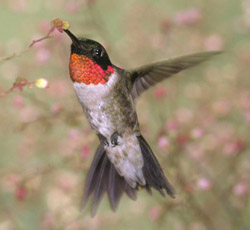Birds of the Mid-Atlantic #18: Ruby-throated Hummingbird
 A characteristic bird of summer in the Mid-Atlanic region is the ruby-throated hummingbird. These unique birds are the smallest in eastern North America and have distinctively-shaped bodies. Though hard to spot, they are easy to identify because of their squat body shape and long, needle-like bills. Ruby-throated hummingbirds have iridescent green heads and backs with white breasts and bellies. Males have a red throat that females lack.
A characteristic bird of summer in the Mid-Atlanic region is the ruby-throated hummingbird. These unique birds are the smallest in eastern North America and have distinctively-shaped bodies. Though hard to spot, they are easy to identify because of their squat body shape and long, needle-like bills. Ruby-throated hummingbirds have iridescent green heads and backs with white breasts and bellies. Males have a red throat that females lack.Ruby-throated Hummingbird / Photo by USDA (via Wikimedia)
Hummingbird flight varies between fast and direct for forward flight and hovering at a near standstill for foraging. The flight of hummingbirds is so insect-like that many beginning birders and non-birders are surprised to learn that they are birds when they first see them. This insect-like flight is itself a useful field mark for identifying hummingbirds from other creatures. Look for something larger than an insect that flies like one.
Their flight is adapted for its foraging techniques, which center on two types of food. A hummingbird gains energy by drinking the nectar from flowers of various plants and trees. As a supplement, it may use a feeder if one is available. In either case, a hummer will hover and the food source and drink. Further nourishment is derived from catching small insects in midair. Sometimes one will see a hummingbird hover to glean insects and spiders from tree limbs.
Here is a video of some ruby-throated hummingbirds in action, mostly around a feeder. Both male and female are shown, with the frames slowed down to show wing action. It also includes a short clip of a sphinx moth, which may be confused with a hummingbird. The last shot of this video shows a characteristic feature of hummingbird plumage, namely its ability to change apparent color depending on the angle of the light. The head and throat feathers may at times appear black, only to flash red when hit directly by sunlight, as happens here. Here is a normal-speed video of feeding ruby-throated hummingbirds.
For most of the year, the ruby-throated hummingbird is the only hummingbird that is likely to be found in the Mid-Atlantic, or in eastern North America generally. It is our only breeding hummingbird. In the late fall and early winter, some western hummingbirds pass through this area and may even spend the winter if food is available. The most likely to appear is the rufous hummingbird. Other western hummingbirds that have been recorded in D.C. and Maryland include .... A few years ago, black-chinned and rufous hummingbirds at the Smithsonian Arts and Industries Building caused quite a stir among DC birders. Most western hummingbirds that winter along the east coast are immatures that took too much of an easterly route on their flight south, so identification of winter hummingbirds can be tricky.
You can attract hummingbirds to your yard with appropriate plantings and hummingbird feeders. Many types of flowers will attract hummingbirds, including salvia, cardinal flower, foxglove, jewelweed, and trumpet creeper. Plantings to attract hummingbirds will draw many butterfly species as well. A longer list of flowers is here.
Commercial feeders are available online and in nature stores. Fill these with a solution of one part sugar to four parts water. Clean feeders and refresh the solution regularly to prevent the spread of disease. Leave the feeders up in November and December if you would like to try to attract a migrating rufous hummingbird or other western species. For recommendations on maintaining feeders, see Hummingbirds.net and Rubythroat.org. For more information on winter hummingbirds, see Trochilids.com.
A hummingbird at a feeder or other food source may act aggressively towards other hummingbirds. For an example, see this video of two hummingbirds fighting over a single feeder. If you turn up the volume you can hear their chattering. For such small animals they are very feisty.
Labels: Birds of the Mid-Atlantic












1 Comments:
At Sunday, 20 August, 2006, John B. said…
John B. said…
Thanks for the compliment, Tim. Bird populations do fluctuate from year to year for a variety of reasons. Let's hope the hummingbird decline is not the start of a long term trend! Feeders are only one of many sources that hummingbirds will use, which include flowers for nectar and insects for protein. If there is more abundance in other food sources, hummingbirds might be less likely to use the feeder. Maybe someone else in the neighborhood has set up a feeding station.
Post a Comment
<< Home